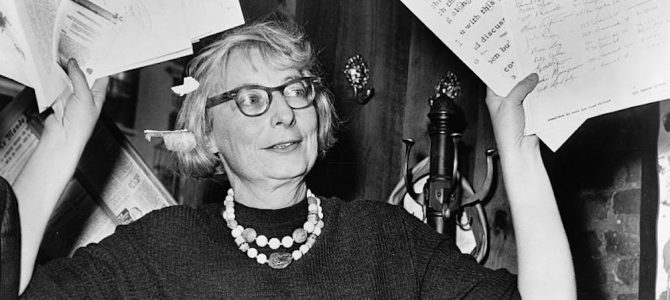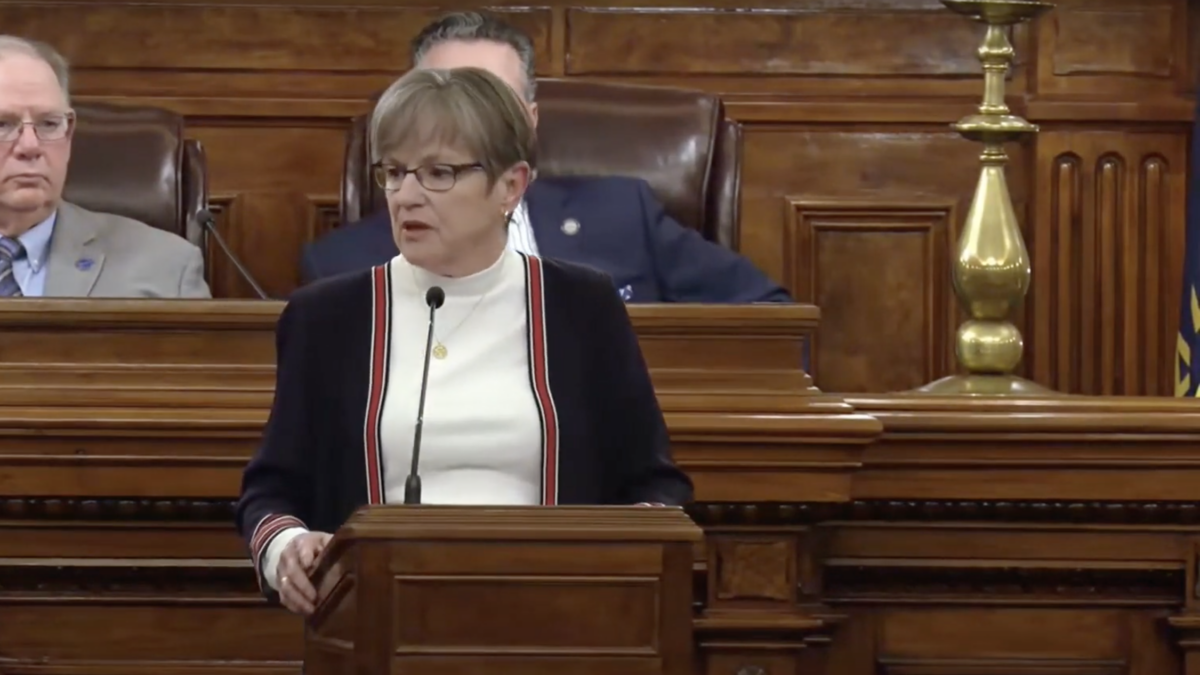
When Jane Jacobs wrote “The Death and Life of Great American Cities,” America looked pretty different. There were no cell phones, no Internet. People were clacking away at typewriters and driving station wagons. Urban cities, large and frenetic as they were, did not compare to today’s megalopolises.
The population of New York City has jumped by nearly one million since Jacobs’ classic work was penned; meanwhile, we’ve seen one of the country’s bastions of commerce and innovation—Detroit—fall into decay. So what does Jane Jacobs have to teach us today? Are her observations on urbanism surviving the test of time?
Who, Exactly, Is Jane Jacobs?
Jane Jacobs was born in 1916, in Scranton, Pennsylvania. Her father was a doctor, her mother a nurse. After high school, she worked as a woman’s page editor for the Scranton Tribune. She never got a college degree.
During the Great Depression, Jacobs moved to New York City with her sister, where they eventually settled in Greenwich Village. Far from the posh and polished enclave it is today, Greenwich Village was a community of working-class people in Jacobs’ day. Even while she freelanced for publications like the Sunday Herald Tribune and Vogue, Jacobs focused her writing on working-class communities. Following her marriage to Robert Hyde Jacobs Jr., the couple eschewed the “parasitic” suburbs to continue living in Greenwich Village.
In 1952, Jacobs began writing for Architectural Forum. After she was assigned a piece on Edmund Bacon’s Philadelphia development project, Jacobs disrupted expectation by criticizing the venture:
…I said, ‘Where are the people?’ [Bacon] didn’t answer. He only said, ‘They don’t appreciate these things.’ At that moment, Jacobs realized that the high-rise projects that Bacon was so proud of had been designed with total disregard for the people who would actually inhabit them.
After this story, Jacobs began to disrupt the urban planning establishment. At a lecture she delivered to key urban planning leaders at Harvard University in 1956, she urged them to “respect – in the deepest sense – strips of chaos that have a weird wisdom of their own not yet encompassed in our concept of urban order.”
This served as the beginning of her written advocacy for cities—and, more importantly, for the people living in them.
Scale Matters — A Lot
Much of Jacobs’ writing focuses on the city street: it’s not just for cars, she tells us. It’s for the people. Walkability fosters presence, and presence fosters safety. She writes in “American Cities,”
Under the seeming disorder of the old city, wherever the city is working successfully, is a marvelous order for maintaining the safety of the streets and the freedom of the city. It is a complex order. Its essence is intricacy of sidewalk use, bringing with it a constant succession of eyes. This order is all composed of movement and change, and although it is life, not art, we may fancifully call it the art form of the city and liken it to the dance—not to a simple-minded precision dance with everyone kicking up at the same time, twirling in unison and bowing off en masse, but to an intricate ballet in which the individual dancers and ensembles all have distinct parts which miraculously reinforce each other and compose an orderly whole.
Perhaps Jacobs illustrates this best when discussing children at play in the city. Super blocks and parks, she observed, were often dangerous for children in the projects: they existed away from adult eyes, and thus often made small children vulnerable to bullies. The open sidewalk, however, was surrounded by working adults, and thus provided space for monitored play. Despite the dust and grime of the street, children were safer—and happier—than they were in the fancy park some blocks away.
The street belongs to everyone. It facilitates commerce and culture, community and confidence in a way other city constructs do not. As such, Jacobs didn’t want to expand streets outside their neighborhood bounds. To do so would rip the essential fabric it nurtured.
Cars and Roads Aren’t Ends In Themselves
This year, filmmakers Matt Tyrnauer and Corey Reeser have released “Citizen Jane: Battle For the City,” which chronicles Jacobs’ efforts to stop the efforts of “master builder” Robert Moses to demolish Upper Manhattan and replace it with a four-lane highway. Moses was funding his plan as “slum clearance,” as part of Title I of the 1949 Housing Act.
“There is nobody against this,” Robert Moses insisted at the plan’s hearing in 1958. “Nobody, nobody, nobody but a bunch of … a bunch of mothers.”
Jacobs organized a grassroots campaign to stop Moses’ project: “gliding around town on her bicycle, corralling campaign into action.” She saw beauty where others, in her time, saw only “hell’s hundred acres.”
At Jacobs’ time, urban planners were trying to usher in a “brave new world” of design. Much of their efforts were catered around skyscrapers, and entirely beholden to the car (much like today’s planners plot the future of “smart cities”). But Jacobs saw the worth in old, historic neighborhoods that others saw as antiquated and obsolete.
Ironically, the neighborhoods Jacobs saved from Moses became gentrified. They are now home to the wealthiest New York dwellers. The same is happening in cities like Washington DC—people want old homes, old neighborhoods. They see value in them, the aesthetic and quality that make them appealing.
But that’s not the reason Jacobs valued them. Certainly, she prized the beauty of the buildings. But she was primarily concerned with the economic and social goods they fostered. They were less expensive for a community to use and upkeep, and thus became “incubators of industry.” By their architecture and scale, they encouraged a social capital that fostered vibrant and safe community. And that’s what mattered most.
American Cities (and Towns) Are Losing Community
All of these elements of Jacobs’ thought are important for two reasons.
First, urban planners are increasingly trying to adopt these sorts of methods in their planning. They’ve followed Jacobs’ “formulas,” insomuch as she’s offered them. They’re attempting to promulgate a vision that’s properly scaled, vibrant, dense.
But it seems that many of today’s urban planners have lost the heart of Jacobs’ work, because they’re planning for a demographic she didn’t know or write for. Jacobs largely wrote about working-class communities—diverse in age and experience, overflowing with disparate ages. Many of them would have been church attenders, sending kids to local schools and going to local markets. They may even have attended community meetings with some regularity.
Jacobs described streets that fostered greater belonging and community among folks who were already—by their nature and their circumstances—prompted to community in the first place. They were the folks stepping outside their front door and going on walks, with some regularity.
Today, we face an altogether different, and more troubling, reality. Americans commute far from their front doors. They send their kids to school in one place, go to the grocery store in another, and attend church (if they go to church) in yet another. Thus, no matter the vibrance of their streets, fewer threads attach them to it. That dynamic changes everything, and it’s difficult to determine how best to curate an urban dynamic that assuages this dilemma.
In addition to this (or because of this), America’s cities and suburbs are becoming ever more like cities. According to Jacobs, the city differs from the town or suburb because “cities are, by definition, full of strangers.” In one’s town, she assumed, you would know most people walking down the street, whereas in the city, this was unlikely. But nowadays, most folks—due to the reasons described above—are unlikely to feel they have a strong community fabric in their town or suburb of residence. That means Jacobs’ theories are applying to more of us over time, not less.
The Curse of the Suburbs
Another reason Jacobs matters is, quite simply, because we’re realizing the detriments of the road and suburb like never before. Giant freeways stretch like a snake across American cities, slicing them in pieces wherever they run, separating communities and obliterating walkability.
Many suburbs, once enclaves of middle-class gentility, have become run-down and are falling into disrepair. Instead of renovating and renewing old suburbs, urban planners keep building newer, grander, “smarter” copycats of the old, deteriorating suburbs. Separated as they are from the fabric of commerce and culture, or anything that might help dignify and revive them, suburbs are becoming the new slums. And they lack any of the intrinsic value that might save them.
Solving this dilemma requires much more than a demolishment plan. It will require a new attitude toward suburban and municipal planning, one that understands the long-term consequences of these designs. It will require a bit of Jane Jacobs, perhaps.
We Need Jane Jacobs, Now More Than Ever
Jane Jacobs was a journalist and activist who walked the streets of the city, and detailed what she saw. She drew observations that continue to shape urban planning today.
“The Death and Life of Great American Cities was a rallying cry against the destruction the broad brush of postwar urban renewal was wreaking on the fine grain of the city,” notes Oliver Wainwright over at The Guardian.
It was more than that: it was a comment on community, and the private associations that make our communities work. And that’s why we need it now, more than ever.









